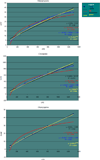Antipsychotic dose equivalents and dose-years: a standardized method for comparing exposure to different drugs
- PMID: 19897178
- PMCID: PMC3677042
- DOI: 10.1016/j.biopsych.2009.08.040
Antipsychotic dose equivalents and dose-years: a standardized method for comparing exposure to different drugs
Abstract
Background: A standardized quantitative method for comparing dosages of different drugs is a useful tool for designing clinical trials and for examining the effects of long-term medication side effects such as tardive dyskinesia. Such a method requires establishing dose equivalents. An expert consensus group has published charts of equivalent doses for various antipsychotic medications for first- and second-generation medications. These charts were used in this study.
Methods: Regression was used to compare each drug in the experts' charts to chlorpromazine and haloperidol and to create formulas for each relationship. The formulas were solved for chlorpromazine 100 mg and haloperidol 2 mg to derive new chlorpromazine and haloperidol equivalents. The formulas were incorporated into our definition of dose-years such that 100 mg/day of chlorpromazine equivalent or 2 mg/day of haloperidol equivalent taken for 1 year is equal to one dose-year.
Results: All comparisons to chlorpromazine and haloperidol were highly linear with R(2) values greater than .9. A power transformation further improved linearity.
Conclusions: By deriving a unique formula that converts doses to chlorpromazine or haloperidol equivalents, we can compare otherwise dissimilar drugs. These equivalents can be multiplied by the time an individual has been on a given dose to derive a cumulative value measured in dose-years in the form of (chlorpromazine equivalent in mg) x (time on dose measured in years). After each dose has been converted to dose-years, the results can be summed to provide a cumulative quantitative measure of lifetime exposure.
Copyright 2010 Society of Biological Psychiatry. Published by Elsevier Inc. All rights reserved.
Conflict of interest statement
Competing Interests: Dr. Andreasen has received honoraria for a lecture from Eli Lilly and a lecture honorarium, an advisory board consulting fee, and research funding from Janssen-Cilag; Dr. Miller has received consulting fees from Organon Schering Plough and Otsuka Pharmaceuticals; Dr. Ho has received research funding from Janssen-Cilag. Drs. Nopoulos and Pressler reported no biomedical financial interests or potential conflicts of interest.
Figures
References
-
- Andreasen NC, Flaum M, Arndt S. The comprehensive assessment of symptoms and history (CASH). An instrument for assessing diagnosis and psychopathology. Arch Gen Psychiatry. 1992;49:615–623. - PubMed
-
- Miller DD, Flaum M, Nopoulos P, Arndt S, Andreasen NC. The concept of dose years: A reliable method for calculating lifetime psychotropic drug exposure. Schizophr Res. 1995;15:159.
-
- Davis JM. Dose equivalence of the antipsychotic drugs. J Psychiatr Res. 1974;11:65–69. - PubMed
-
- Woods SW. Chlorpromazine equivalent doses for the newer atypical antipsychotics. J Clin Psychiatry. 2003;64:663–667. - PubMed
-
- Kane JM, Leucht S, Carpenter D, Docherty JP. The expert consensus guideline series. Optimizing pharmacologic treatment of psychotic disorders. Introduction: Methods, commentary, and summary. J Clin Psychiatry. 2003;64(suppl 12):5–19. - PubMed
Publication types
MeSH terms
Substances
Grants and funding
LinkOut - more resources
Full Text Sources


